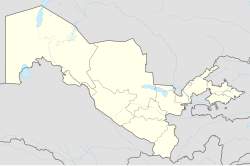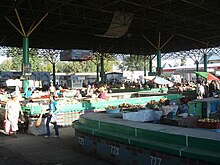Fargʻona
|
Fargʻona арғона |
||
| Basic data | ||
|---|---|---|
| State : |
|
|
| Province: | Fargʻona | |
| Coordinates : | 40 ° 23 ' N , 71 ° 47' E | |
|
|
||
| Height : | 582 m | |
| Residents : | 187.100 | |
| Agglomeration : | 513,449 | |
| Telephone code : | (+998) 73 | |
Fargʻona , also known as Ferghana in German (Uzbek-Cyrillic Фарғона; Russian Фергана Fergana ; Persian فرغانه, DMG Farġāna ), is a city (shahar) in the Ferghana Valley in eastern Uzbekistan and the capital of the Fargʻona province . Around 187,100 people live in the city itself and just under 500,000 in the enlarged agglomeration. It is the industrial center (petrochemicals, textile industry ) and the cultural center of the area with universities and theaters . Fargʻona was built as a colonial re-establishment next to the ancient city of Margʻilon and was known as Nowy Margelan until the 20th century .
history
Research into Ferghana's Bronze Age began in the 1930s. A station near Khust was excavated by IV Sirisevsky. In addition to tableware, ceramics included thin-walled goods. Black patterns (hatched triangles, sometimes also spirals) were applied to a red background. The walled settlement of Dal'verzin also belongs to this culture. The excavators found sickles and bones of cattle, sheep, goats, horses, donkeys, pigs and dogs. The tools were made of bronze, stone and bone. After 160 BC BC the Saks founded an empire. For a time Ferghanas belonged to Kushana . The country benefited from the caravan trade on the Silk Road . The Chinese particularly valued the horses from Ferghana. Clay figures from the late Han and Tang periods probably represent these imported horses. Until the 4th century AD, Kurgan - necropolises of the nomads arose ; the country flourished as the Dayuan homeland . Another form of grave from this time was the so-called Kurum or Hug-chana, a round burial chamber made of stones with a dome-shaped roof.
Attractions

In the 18th century Fargʻona was still a small village, developed into a political center during the period of Russian expansion in Central Asia and played an important role in the " Great Game ", a rivalry between the Russian and British empires for rule in Asia .
Fargʻona is known less for its architectural masterpieces than for the beauty of nature. The city is often compared to a huge garden, which is especially beautiful in spring . Plane trees , oaks and white locust trees give the streets the appearance of avenues. The local parks and green spaces are broad. After the variety of decorative trees and shrubs they are reminiscent of a botanical garden and after the many flower and lawn areas of a rosarium .
The social life in Fargʻona is a mixture of western and traditional Uzbek influences. In addition to the modern restaurants, bars and nightclubs you can also see oriental bazaars , old historical buildings and shops for handicrafts. The population today consists mainly of Uzbeks , with significant minorities of Russians , Tatars , Ukrainians , Koreans and Tajiks .
Fargʻona has also been known for its silk and pottery since the Silk Road era .
sons and daughters of the town
- Alexander Volkov (1886–1957), Russian painter
- Inamschon Usmanchodschajew (1930-2017), Soviet or Uzbek politician
- Enwer Ismailow (* 1955), Ukrainian (Crimean Tatar) musician
- Qairat Omarow (* 1963), Kazakh politician and diplomat, Ambassador to the United States
- Isajon Sulton (* 1967), writer and translator
- Lusja Shatalova (* 1968), designer and children's book illustrator
- Gulnora Karimova (* 1972), politician, diplomat and entrepreneur
- Sergei Tetjuchin (* 1975), Russian volleyball player
- Rafael Nuritdinov (* 1977), racing cyclist
- Timur Kapadze (* 1981), football player
- Sergey Lagutin (* 1981), Russian-Uzbek cyclist
- Bahram Muzaffer (* 1986), Turkish boxer
- Irina Potejewa (* 1986), Russian boxer
- Sardor Mirzaev (* 1991), Uzbek football player
Climate table
| Fargʻona | ||||||||||||||||||||||||||||||||||||||||||||||||
|---|---|---|---|---|---|---|---|---|---|---|---|---|---|---|---|---|---|---|---|---|---|---|---|---|---|---|---|---|---|---|---|---|---|---|---|---|---|---|---|---|---|---|---|---|---|---|---|---|
| Climate diagram | ||||||||||||||||||||||||||||||||||||||||||||||||
| ||||||||||||||||||||||||||||||||||||||||||||||||
|
Average monthly temperatures and rainfall for Fargʻona
Source: wetterkontor.de
|
|||||||||||||||||||||||||||||||||||||||||||||||||||||||||||||||||||||||||||||||||||||||||||||||||||||||||||||||||||||||||||||||||||||||||||||||||||||||||||||||||||||

